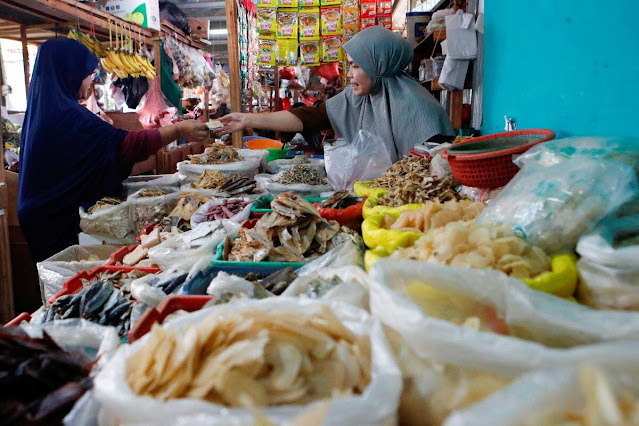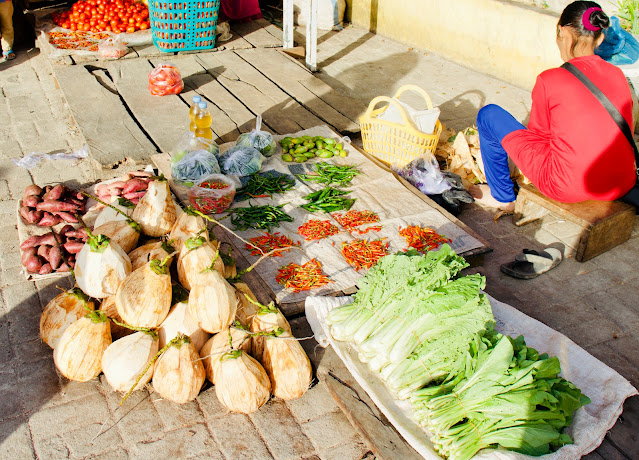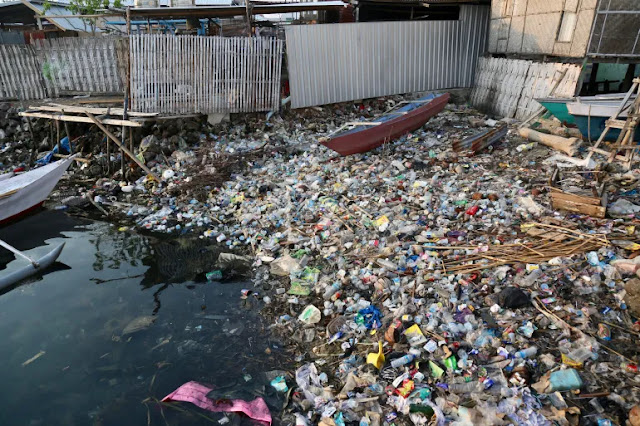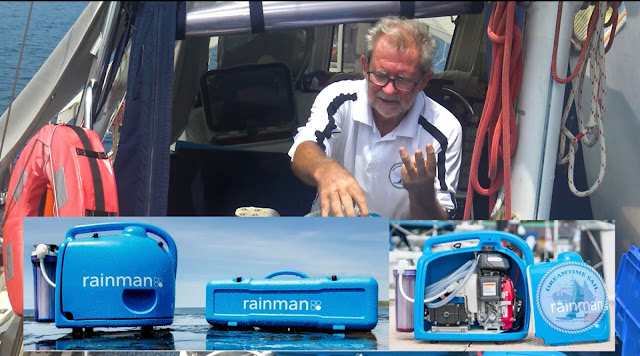 |
| A countertop can be made of anything. I find the markets much more interesting than a supermarket |
To rise early in the morning to purchase the best and freshest produce at the traditional markets has literally become part of our lives. Even if you are not purchasing at these Markets they are meant to be seen and enjoyed — full of locals and with counters brimming with ripe fresh produce and household staples.
 |
| Dried and salted fish. |
Traditional markets are still at the heart of everyday life in Indonesia. They are usually known as 'wet markets' they are packed with people trading everyday of the week. Here you can find various basic daily needs where buyers can meet directly with sellers and can bargain prices. Besides, markets tend to be more affordable, and groceries such as vegetables and food are fresher. We will be purchasing our fresh vegetables, fruit and protein from these traditional markets as we sail through the archipelago.
 |
| Here part of the street becomes the market. Nobody minds they just drive or ride around the stalls. |
Traditional markets are called Pasar in Indonesian, and Pasar Besar meaning big market. Some of them are very large, mostly unique, all inexpensive, and you can find them everywhere, some are small and catering for only a few villages within walking distance, but at every market you will find a good variety of fresh produce to keep your supplies topped up.
 |
| Take your own bags and containers as everyone will try to give you plastic. |
Not surprisingly, these markets cater all kinds of needs, ranging from traditional culinary to various cooking utensils and some even have a variety of clothing. In the Pasar Besar (big market) you can find shops with basic needs in bulk like rice, beans, sugar, oil, flour, etc for retail. Locals buy in a larger amounts for resale in the small village shops.
 |
| The markets are crowded, busy, noisy but oh so colourful |
There are a number of different traditional markets. What is referred to as a “wet” market is where you will find protein, fish, chicken and red meat and they normally operate from very early in the morning until mid morning where stocks are very low from 9am. You will also find this the case for the fruit and vegetable markets. However contrary to this we have found a couple of night markets. For the “wet and traditional markets” I suggest you to go in the morning (7-8 am) so it will not be too hot, take small notes and learn the basic numbers so you can understand the price.
 |
| All sorts of seafood can be found. |
 |
| If you want protein you must be willing to head to the “Wet Market” |
There are no beautifully arranged goods in refrigeration here. Most of the vendors sell small bundles. The produce is sometimes artistically arranged and at other times it’s hap-hazzard. I also found they usually specialise in what they sell. Some vendors only selling chilli, another may only be selling garlic and the egg man is definitely where you get your eggs. Why because they sell to the same people each day, purchases are made on a daily basis. The egg vendor will carefully check each egg via a light to see if they are fresh and usually using twine bundle up however many trays you want creating a handle for you to carry your eggs by. We have found carrying eggs in this manner to be a dangerous occupation via, bike/bus, walking, dinghy ride in sometimes choppy weather, so we have reusable egg cartons. We get strange looks when we present them to be filled. But better that than egg mishaps all the way back to the boat.
 |
| Karen getting our egg boxes filled. |
 |
| Only beautiful ripe red tomatoes and chilies available at this stall. |
Indonesian traditional markets are one of the main economic centres, where farmers, fishermen, gardener, can sell their products and consumers can buy them at a much cheaper price. The market is a part of social life, where everyone gathers daily to buy their supplies. These activities are a means of community activities and social network. The the atmosphere at traditional markets is lively. Vendors and buyers chat with each other because they see each other regularly. There is a kind of friendship appeared between vendors and their loyal customers. It is loud, there are no price tags, you must ask the price and then haggle until “best” price is found, whereby both seller and purchaser are happy.
 |
| A larger selection of produce beautifully displayed. |
Everyone is very polite in their bartering, sometimes it’s quite comical to watch as the facial expressions and body language tell you more about the transaction than the rapidly spoken words. There is one thing that I found amusing, there are some ladies from whom I have bought from, who call me “dear”. They might also say it to all of their clients I guess, but it is always funny to me every time I am referred to in this way.
 |
| Choose the fish with the clear eyes and it shouldn’t smell fishy |
Recently a beautiful young vendor had pineapples for sale. Her price for 9 pineapples was 50k (to me). However I had just seen her take 25k from a local. With much smiling and saying “tidak” (no) about the price and pointing to the woman who was walking away with her 9 for half the price, I had no luck she just beamed and said 50k, I gave in and paid my $5 Australian for my 9 pineapples. As westerners be prepared to pay a little more for your produce. They aren’t purposely (well I suppose they are) ripping you off, but if you know your numbers and a few pleasantries followed by a big smile you can normally get a good price, and $5 for 9 pineapples not bad but very “good” (bargus) price compared to Australia. Such is life being the only westerner in the market with red hair, I sort of stick out.
 |
| Night market Wanci Wakatobi |
Our favourite night market so far has been Wanci in Wakatobi. As soon as the sun is setting, the night market in Wanci comes to life. It offers a great choice of the freshest seafood, vegetables and fruits. You can see the day’s catch spread out on wooden tables, in buckets or on the floor. Yes whole fish just lying on the floor. A wide variety of snapper, tuna, barracuda, crabs and the foodies delight, sea urchins, are all for sale. The sea urchins are best enjoyed raw or slightly steamed and are offered at an unbeatable price. In front of the market, grilled fish and a variety of traditional dishes are prepared for you to enjoy on the spot or to take away. My favourite were the ladies selling all sorts of pastries, cakes and donuts, they were deLISH. I would always turn up with a small gift for the children of these stall holders, and a few extra donuts I found were always placed into my bag. The night market is located at Marina Bay close to where we moored the boat, it opens around 4 pm in the afternoon the night market can certainly entertain you for a few hours even if you are not purchasing.
 |
| Everything is weight with antique scales, no need for new electronic versions |
After purchasing our food at the markets, I clean all the fruit and vegetables in a solution of 1:5 vinegar and water. Soaking and scrubbing those that can be scrubbed. Drying and then storing them. Meat I wash in 1:10 vinegar to water, rinse in water and dry before cryovac and freezing. After you see how the produce is transported and then displayed you will understand why I do this.
However when you do find a supermarket! You go absolutely bonkers!!! But you pay the price for it!
 |
| How ridiculous do these capsicums look wrapped in plastic. |
You can find more info on how I store produce on Dreamtimesail blog under Our Galley tab at the top of this page, plus check out the contents page for more detailed information and more blogs.
TIPS:
- take cloth bags to carry your produce, they want to give you plastic for everything. (Which we forgot in Tual 😳)
- take small notes.
- learn a few words like numbers, how much, thank you, and if you want to be more adventurous the names of the produce.
- take small gifts for the children. We have little keyring koalas, we always give out 6 or so each market visit.
- take your own reusable egg cartons (their egg trays contain 30 eggs) and containers for other things like sweets, donuts, rice, chickpeas all of these and more are not sold in packets, I found it easy for the vendor to weight the item then just pour it into my container.
















